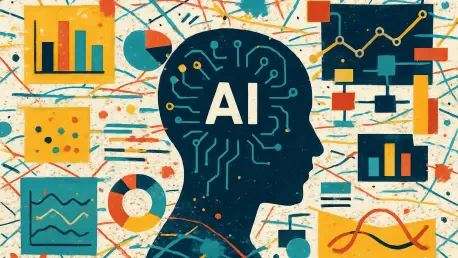In the ever-evolving landscape of business intelligence, the notion of data as a cornerstone of success is nothing new, but the type of data driving that success is undergoing a dramatic transformation. For years, the focus has been on clean, structured datasets—information meticulously organized to fuel actionable insights. Companies have invested heavily in systems and processes to ensure data purity, often viewing anything less as a hindrance. Yet, a profound shift is taking place, driven by breakthroughs in artificial intelligence (AI). Messy, unstructured data, once dismissed as problematic, is now being recognized as a potential treasure trove. This article delves into how embracing the chaos of imperfect data can offer businesses a distinct competitive edge, turning what was once a liability into a powerful tool for innovation and differentiation in a data-saturated world.
Rethinking the Past: The Reign of Clean Data
The pursuit of clean data has long been a fundamental principle in data science, rooted in the belief that only structured information could yield reliable outcomes. This conviction shaped the big data movement, leading to the development of sophisticated architectures like data lakes and warehouses, all designed to house pristine datasets ready for immediate analysis. The process of data cleaning became an indispensable ritual, with teams dedicating substantial resources to eliminate errors, inconsistencies, and ambiguities. Without this step, the prevailing wisdom held, any attempt at meaningful analysis was doomed to fail. This rigid focus on cleanliness not only defined operational strategies but also marginalized messy data, relegating it to the status of unusable clutter in the eyes of most organizations.
This obsession with structure created a culture where data quality was synonymous with business success, often at the expense of exploring alternative sources of information. Entire industries aligned around the idea that clean data was the only path forward, investing in tools and talent to maintain this standard. Messy data, by contrast, was seen as a problem to be avoided rather than a potential asset. The consequence was a narrow view of data’s value, one that overlooked the richness hidden within less polished datasets. As a result, countless opportunities for insight remained untapped, buried under the assumption that only order could produce results, setting the stage for a paradigm shift driven by new technological capabilities.
AI Revolution: Turning Chaos into Opportunity
Artificial intelligence, particularly through advancements in large language models (LLMs) and image recognition technologies, is fundamentally altering how businesses approach data management. These cutting-edge tools are adept at navigating the complexities of unstructured, inconsistent, or incomplete information—whether it’s clickstream data with erratic URL patterns, machine-generated logs in obscure formats, or customer feedback peppered with slang and emojis. Unlike traditional analytical methods that require strict formatting to function, AI prioritizes extracting meaning and intent over adhering to rigid structures. This ability to make sense of chaos transforms messy data from a persistent obstacle into a valuable resource for companies willing to adapt to these innovative approaches.
Beyond merely processing difficult datasets, AI offers a deeper level of understanding that was previously unattainable with conventional tools. It can sift through raw IoT telemetry data plagued by noise and dropouts or analyze image and video files using advanced computer vision to reveal hidden patterns. This shift is not just technical but strategic, as it allows businesses to leverage information that competitors might disregard as unusable. The implications are significant: organizations can now access insights from sources once thought irrelevant, gaining an edge by capitalizing on data diversity. As AI continues to evolve, the barriers to working with messy data are rapidly diminishing, opening new avenues for innovation across industries.
Unlocking Deeper Value: From Syntax to Semantics
One of the most transformative aspects of AI in data analysis is its capacity to move beyond surface-level information to a more profound semantic understanding. Rather than simply breaking down a disordered URL string or decoding a log file’s syntax, AI can infer user intentions, behaviors, and motivations behind the data. For example, it might reveal why a customer clicked on a specific link or what frustrations lie beneath a piece of feedback. This leap from basic data parsing to meaningful interpretation unlocks entirely new categories of information, providing richer, more actionable intelligence that can directly inform business strategies and decision-making processes.
This focus on semantics allows companies to explore data sources that others might overlook, creating opportunities for differentiation in saturated markets. By understanding not just what the data shows but what it implies, businesses can develop predictive rather than merely reactive approaches to challenges. This deeper insight fosters a more nuanced view of customer needs and market trends, enabling tailored solutions that stand out. The competitive advantage lies in seeing beyond the obvious, using AI to extract value from messy data in ways that traditional methods cannot replicate. As a result, organizations positioned to harness these capabilities are better equipped to anticipate shifts and innovate ahead of the curve.
Building Practical Solutions: Tools for the Messy Data Era
The accessibility of modern AI tools is reshaping how businesses can tackle messy data, making sophisticated analysis achievable even for smaller players. Innovations such as function-calling APIs and cost-effective local AI models have enhanced traditional ETL (extract, transform, load) workflows, adapting them to handle unstructured information with greater efficiency. These advancements mean that resource-intensive data cleaning is no longer the sole prerequisite for analysis. Instead, companies can now integrate messy data directly into their processes, using AI to streamline interpretation and application, thus reducing both time and cost barriers that once limited such efforts.
A key opportunity lies in identifying overlooked data sources within an organization—often referred to as “digital droppings.” These might include neglected logs, archived records, or secondary outputs that have been ignored due to their lack of structure. Yet, with the right tools, these datasets can uncover critical insights into customer pain points, preferences, or emerging needs. Businesses are encouraged to audit their data reserves, seeking out these hidden gems that could drive transformative change. By building workflows that embrace rather than resist messiness, organizations can turn chaos into a strategic asset, leveraging modern technology to reveal what lies beneath the surface.
Shaping the Future: Democratization of Data Insights
The broader impact of AI on data analysis signals a new era of democratization, where the ability to extract value from messy data is no longer confined to large enterprises with vast resources. Modern tools empower even individual analysts or small businesses to process complex, unstructured information with relative ease, leveling the playing field in business intelligence. This shift reduces the dependency on extensive data preparation, allowing for quicker, more agile decision-making. The trend underscores a fundamental change in how data’s potential is perceived, moving away from exclusivity toward widespread accessibility across sectors and scales.
Industry consensus among tech and marketing professionals points to a pivotal realization: true competitive advantage now stems from proprietary insights derived from unique, messy data sources rather than from widely available, standardized information. Differentiation arises from uncovering what others cannot see, positioning messy data as a critical business weapon. Companies that adapt to this perspective can harness previously inaccessible information to craft strategies that resonate on a deeper level with their audiences. This evolving landscape suggests that embracing data in all its forms—clean or chaotic—will define the next wave of innovation and success in a data-driven world.
Reflecting on a Data Revolution: Steps Forward
Looking back, the journey from an unwavering focus on clean data to recognizing the potential in messy datasets marked a significant turning point for business intelligence. The rigid structures of the past, while effective for their time, often constrained the scope of insights by sidelining valuable but unstructured information. AI’s emergence as a game-changer shifted this dynamic, equipping organizations with the means to extract meaning from chaos and redefine data’s role in strategy. This evolution highlighted that value often hid in the most unlikely places, waiting to be uncovered by those bold enough to challenge conventional norms.
As businesses move forward, the actionable step is to conduct thorough audits of existing data reserves, seeking out neglected sources like logs or feedback archives that might hold untapped potential. Investing in accessible AI tools to process these datasets can yield insights that set an organization apart. Additionally, fostering a culture that views messiness not as a flaw but as an opportunity can inspire innovative approaches to problem-solving. By prioritizing adaptability and exploration, companies can position themselves to thrive in an era where data, in all its forms, drives the future of competition.









